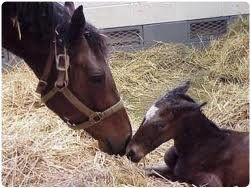Newborn Foal Feet
Let nature guide us - Newborn Foal Feet Development
By Clive Meers Rainger RSS BII, LSMC, NBBT, CNBF, CFS
Let Nature Guide Us
With regard to the optimum conditions for the development of the newborn foals feet
Horses feet are not only governed by the environment in which they kept but also the very start of their existence has a great influence on how good the feet will become. If we take the model of the feral horse, which has over the last forty years been the subject of much research, we will find that the mare will position herself where she has good views of any approaching predators, the predators in the studies being bears, wolves, mountain lions and coyotes. The mare separates herself from the rest of the herd with perhaps one other to stand over her whilst giving birth. Once the foal is born the mare will cleanse (expel the afterbirth). This afterbirth will attract predators from several miles away.

Whilst the mare is cleansing the foal is being encouraged to stand. As with all young animals their first stance is ungainly and A-framed, which is when the feet are wider than the shoulders or hips. As the foal stands this is the first contact the feet will have had with anything firm, as they have been suspended in amniotic fluid during their development inside the mare and although the feet contain the pedal bone, lateral cartilages', digital cushion and other various tendons and ligaments, they have not been asked to do the job nature intends of them, being as they are under-developed, as they have not received the required stimulation for their development. This stimulus is provided from the pressure of the foot on firm ground.
The mare, aware that the afterbirth will be attracting predators will proceed to walk the foal as soon as it is standing as far away from the birth site as possible. The distance the mare will take the foal is often ten to twelve miles and this will often be done before a foal feeds. Situated in the feet are nerve endings known as propreal receptors and these allow a horse to know where its feet are and also the type of ground over which it is travelling.
These propreal receptors whilst sending messages to the brain receive messages back correcting the foal's stance and allowing the feet to stand beneath the hips and shoulders and within a few hours allow the foal to run at high speeds within the herd if they are pursued by predators. This is an incredible though that within a few hours of birth a foal can achieve speeds of up to twenty-five to thirty miles an hour to keep up with his mother but this is only possible by the propreal receptors positioning the legs so that the weight falls through the centre of each joint, allowing maximum speed for minimal muscular exertion.

Now compare this to our domestic model where mares are asked to foal in boxes which do not allow them to see what is around. Quite often in the field the mare will have chosen the place she feels safest to foal and will normally foal in the early morning as this is naturally the time when predators are least active as there pursuit of food is normally over by this time, giving her a safe window in which to get her foal on its feet and back to the herd.

We also fill the box will masses of soft bedding in the belief that the softer the bedding the less injuries are likely to happen to the foal. However, if as the foal gets up the underside of its feet are coming in contact with soft unstable bedding the propreal receptors are inappropriately stimulated and the legs can, in many domestic horses, become misshapen and deformed.
In a study carried out by Dr Robert Bowker it was found that if a mare was given a well drained field and field shelter to use if that was her choice, the foals by day one would be found to have strong, well aligned limbs as opposed to their well bred cousins being looked after in the best possible way to protect them but not offering a foal the things it requires to stimulate limb alignment and hoof quality that it will require in later life.
If we quickly look at the thoroughbred breeding industry we see the need for products and shoeing methods to correct many limb deformities in foals. This is then attributed to being typical thoroughbred problems and not to our misunderstanding of nature's requirements. Compare this to the horses of the traveller community where, for the most part, they are left to their own devices and where there is virtual non-existence of deformities, which we interpret as a breed fault and not a misunderstanding on our part. It would appear that the more a horse is thought to be worth the more cotton wool it will be wrapped in and the more we wrap the less we stimulate natures own foolproof system of turning a newborn foal into a running machine, which is achieved by the stimulation of the underside of a foot.
When a foal is born the largest thing on the bottom of it's foot is the frog and it is on this they will walk, trot, run, gallop etc, and it is standing on the frog that increases blood flow and, in conjunction with the digital cushion and lateral cartledges, it keeps the pedal bone in it's appropriate place and causes these structures to strengthen and develop to enable them to carry a disproportionate amount of weight for their size in the mature horse. It has also been proved that the stimulation given to a foal's foot in the first few months of life determines the size the feet will become. Less stimulation produces smaller feet and therefore puts the foot under greater stress with the weight being distributed over a smaller area when mature.
It has therefore been proved that if we can, in the safest possible way, imitate nature the confirmation and soundness of the next generation of our equine friends will be assured.
By Clive Meers Rainger RSS BII, LSMC, NBBT, CNBF, CFS,
© www.equinefootprotection.co.uk Natural Balance Farrier in Kent 2010 all rights reserved, no copying of this article in part or in full without prior consent.

“ I have no doubt that it is wholly though Clive’s skill and patience that Fig is still with us today and is comfortably enjoying his happy retirement… Thank you.”
Julia

“Just a word of thanks, to you Clive, for your consistently outstanding care for the horses.”
Mark
Get in touch with Clive
If you would like to know more about Equine Foot Protection or you have specific question about Natural Balance Farriery or to discuss your particular Farriery needs or just to book an appointment please fill out the for below and we will get back to you
Thank you for contacting us.
We will get back to you as soon as possible
We will get back to you as soon as possible
Oops, there was an error sending your message.
Please try again later
Please try again later
About EFP
With over 45 years of experience Clive has dedicated his career to Farriery and the care of Equine Athletes and Friends alike
Contact info
The Forge, Gabriels Farm, Marsh Green Road, Nr Edenbridge, Kent, TN8 5PP
+44 7884 236892
equinefootprotection@gmail.com

